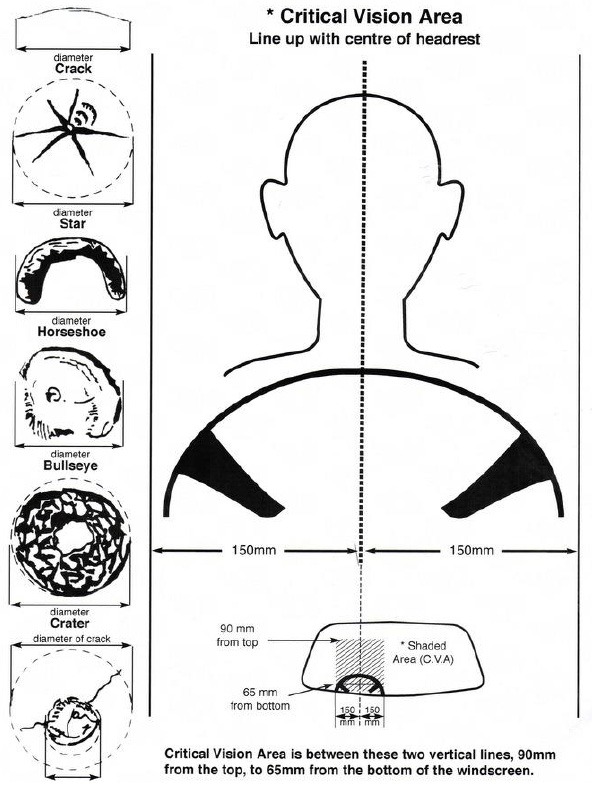Will my windscreen damage stop me from getting a WOF?
If you’re a vehicle owner in New Zealand, you’re unavoidably familiar with the Warrant of Fitness (WOF) inspection – the regular check that ensures your vehicle is roadworthy and safe, and brings on a brief period of high anxiety each year! And one of the most common specific concerns among Kiwi drivers is whether windscreen damage will cause a WOF failure. Let’s take a look at New Zealand’s standards for windscreen damage and what you need to know before your next inspection.
Key Takeaways
- WOF Inspection Areas: Windscreen divided into the Critical Vision Area (CVA) (directly in driver’s sight) and the Outer Zone. Stricter standards apply to the CVA.
- Chip Criteria: Fail if larger than 16mm in CVA, clustered, deep, or developing cracks. Small, isolated chips outside CVA may pass.
- Crack Criteria: Fail if any crack in CVA, over 150mm in length, spiderweb patterns, or reaching the windscreen edge.
- Scratch Criteria: Fail if deep or widespread in CVA, causing hazy vision. Light scratches outside CVA may pass.
- Other Causes for Failure: Discoloration, delamination, poor repairs, wiper issues, or damaged mirrors.
- Driving with Damage: Not illegal, but can result in a fine if visibility is impaired.
- Post-WOF Damage: Repair immediately; unsafe damage can result in fines.
- Insurance Coverage: Many policies cover windscreen repairs with low or no excess.
- Preventative Maintenance: Regular cleaning, timely repairs, replacing wipers, and avoiding temperature stress can help prevent failures.
- Temporary WOF: In some cases, a 28-day Conditional WOF may be granted for minor, repairable issues.
- ADAS Considerations: Vehicles with Advanced Driver Assistance Systems (ADAS) require recalibration after windscreen replacement.
Table of Contents
Understanding WOF Requirements for Windscreens
The NZ Transport Agency (NZTA/Waka Kotahi) has specific guidelines for windscreen condition as part of the WOF inspection. These standards are in place for good reason – your windscreen is a critical safety component that provides structural integrity to your vehicle and ensures clear visibility while driving.
The Primary Inspection Zone
For WOF purposes, your windscreen is divided into two main areas:
- Critical Vision Area (CVA) – This is the section of the windscreen directly in the driver’s line of sight, essentially a 290mm radius area centered on the steering wheel.
- Outer Zone – This comprises the remainder of the windscreen outside the CVA.
The standards are stricter for damage in the Critical Vision Area, as any impairment here directly affects the driver’s visibility.
Types of Windscreen Damage and WOF Standards
Chips
A chip is typically a small point of damage where a stone or other object has struck the windscreen.
WOF Failure Criteria:
- Any chip larger than 16mm in diameter in the Critical Vision Area
- Multiple chips that are close enough together to weaken the glass
- Chips that have started to develop cracks extending from them
- Any chip in the Critical Vision Area that’s deeper than the outer layer of glass
What Can Pass:
- Small chips (under 16mm) outside the Critical Vision Area
- Limited number of small chips that aren’t clustered together
Cracks
Cracks are linear fractures in the glass that can extend across portions of the windscreen.
WOF Failure Criteria:
- Any crack in the Critical Vision Area
- Cracks longer than 150mm in any part of the windscreen
- Multiple cracks that form a pattern resembling a “star” or “spider web”
- Cracks that reach the edge of the windscreen (these compromise structural integrity)
What Can Pass:
- Very short, stable cracks outside the Critical Vision Area that don’t impair visibility
Scratches
Scratches are surface-level damage to the windscreen that can affect visibility, especially in certain lighting conditions.
WOF Failure Criteria:
- Deep or wide scratches in the Critical Vision Area that impair visibility
- Multiple scratches that create a “hazy” effect in the driver’s line of sight
What Can Pass:
- Light surface scratches that don’t significantly affect visibility
Other Windscreen Issues That Can Cause WOF Failure
Beyond chips and cracks, other windscreen issues can lead to a failed WOF:
- Discoloration or cloudiness in the glass that impairs visibility
- Delamination (separation of the glass layers)
- Incorrectly fitted windscreen or poor quality repairs
- Missing or damaged windscreen wipers that don’t adequately clear the glass
- Damaged or missing rear-view mirrors (internal or external)
Common Questions About Windscreen Damage and WOF
Q. Can I drive with a cracked windscreen in New Zealand?
A. While it’s not illegal to drive with a cracked windscreen, you could receive an infringement notice if the damage impairs visibility or makes the vehicle unsafe. Additionally, if your crack meets the failure criteria above, your vehicle won’t pass its WOF inspection.
Q. What if my windscreen gets damaged right after getting a WOF?
A. If significant damage occurs after your WOF inspection, you should get it repaired promptly. Driving with serious windscreen damage can be dangerous and may result in a fine, regardless of having a current WOF.
Q. Will my insurance cover windscreen repair or replacement?
A. Many New Zealand insurance policies include windscreen coverage, sometimes with reduced or no excess for windscreen claims. Check your policy details, as this can make repairing windscreen damage much more affordable.
What to Do If Your Windscreen Has Damage
Before Your WOF Inspection
If you notice windscreen damage before your WOF is due:
- Assess the damage using the criteria above to determine if it’s likely to cause a failure.
- Consider repair options – many chips and small cracks can be repaired rather than requiring full replacement.
- Get it fixed professionally – DIY repair kits exist, but professional repairs are more reliable and likely to pass inspection.
- Don’t delay – small chips and cracks can expand quickly, especially in New Zealand’s variable climate conditions.
If You Fail Your WOF Due to Windscreen Damage
If your vehicle fails its WOF due to windscreen issues:
- Understand the specific reason for failure – ask the inspector to explain exactly what the issue is.
- Get quotes for repair or replacement – shop around, as prices can vary significantly.
- Check your insurance coverage before proceeding with repairs.
- Consider a temporary WOF – in some cases, you may be eligible for a 28-day temporary WOF to allow time for repairs.
The Importance of Windscreen Maintenance
Regular maintenance can prevent minor issues from developing into WOF failures:
- Clean your windscreen properly using appropriate glass cleaners
- Replace windscreen wipers regularly to prevent scratching
- Address chips promptly before they develop into cracks
- Park in shaded areas when possible to reduce thermal stress on the glass
Frequently Asked Questions
Q. How much does it cost to repair a chip or crack before a WOF?
A. In New Zealand, windscreen chip repairs typically cost between $60-$120 depending on the size and location. This is significantly less expensive than a full windscreen replacement, which can range from $300-$1,000+ depending on your vehicle make and model. Many repair shops offer free quotes, so it’s worth calling around.
Q. Can I use a DIY windscreen repair kit to fix damage before my WOF?
A. While DIY repair kits are available for around $20-$40, results can vary significantly. WOF inspectors look for professional-quality repairs, and poorly executed DIY fixes may still result in a failure. DIY repairs are better suited for very minor damage outside the Critical Vision Area, but professional repairs are recommended for WOF purposes.
Q. If my windscreen is repaired rather than replaced, will the repair be visible during WOF?
A. A professionally repaired chip or crack will typically leave a small mark that looks like a bullseye or slight distortion in the glass. This is normal and acceptable for WOF inspection as long as it doesn’t significantly impair visibility. Quality repairs restore about 90-95% of the windscreen’s structural integrity and clarity.
Q. Do older vehicles have different windscreen standards for WOF?
A. No, the WOF standards for windscreen condition are the same regardless of vehicle age. However, sourcing replacement glass for rare or vintage vehicles may take longer, so plan accordingly if you need repairs before your WOF.
Q. Will tinted windscreens affect my WOF inspection?
A. Excessively dark windscreen tinting can cause a WOF failure. In New Zealand, the front windscreen must have a visible light transmission (VLT) of at least 70%, meaning it allows 70% of light through. Aftermarket tinting on front windscreens is generally not permitted.
Q. How long should I wait after windscreen replacement before getting a WOF?
A. Most professional windscreen replacements require a minimum 24-hour curing period for the adhesive to set properly. It’s best to wait at least 1-2 days after replacement before undergoing your WOF inspection to ensure everything has settled correctly.
Q. Are there any temporary exemptions available if I can’t repair my windscreen immediately?
A. In certain circumstances, a Conditional WOF (CWOF) may be issued, giving you 28 days to complete necessary repairs. However, this is at the discretion of the inspector and only for vehicles that are still safe to operate. Serious windscreen damage that compromises safety won’t qualify for a CWOF.
Q. Does windscreen damage affect the structural integrity of my vehicle?
A. Yes, your windscreen provides up to 30% of your vehicle’s structural integrity in the event of a rollover accident. Even relatively minor damage can weaken the glass, potentially compromising this structural support. This is another reason why WOF standards are strict regarding windscreen condition.
Q. Can weather conditions in New Zealand worsen windscreen damage before my WOF?
A. Absolutely. New Zealand’s variable climate can cause existing windscreen damage to spread quickly. Temperature fluctuations (especially in winter), heavy rain, and exposure to direct sunlight can all cause chips and cracks to expand. This is why addressing damage promptly is crucial, especially if your WOF is approaching.
Q. If my vehicle has ADAS (Advanced Driver Assistance Systems), does this affect windscreen repair standards for WOF?
A. Vehicles with ADAS features like lane departure warning or automatic emergency braking often have cameras or sensors mounted to the windscreen. While the WOF standards for glass damage remain the same, proper recalibration of these systems after windscreen repair or replacement is essential. Without proper calibration, your vehicle might fail the WOF or, worse, these safety systems could malfunction while driving.
Final Thoughts
Understanding New Zealand’s WOF standards for windscreen damage can save you time, money, and inconvenience. While minor damage outside the Critical Vision Area may not cause an immediate failure, it’s always best to address windscreen issues promptly.
Remember that these standards exist for good reason – your windscreen is a crucial safety component of your vehicle, providing both structural integrity and clear visibility. When in doubt, consult with a professional auto glass technician who understands the WOF requirements and can advise you on the best course of action.
By maintaining your windscreen and addressing damage early, you’ll not only ensure WOF compliance but also contribute to safer roads for all New Zealanders.



